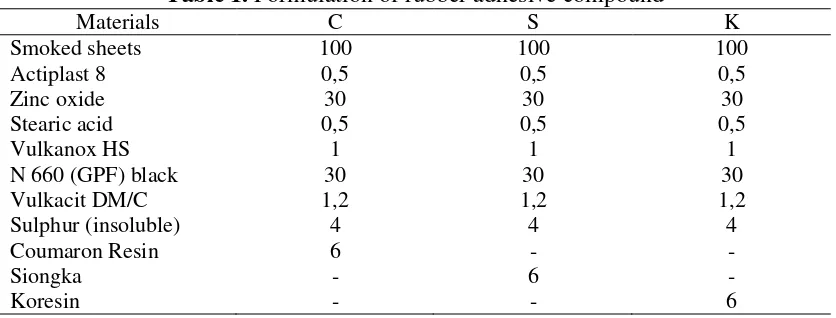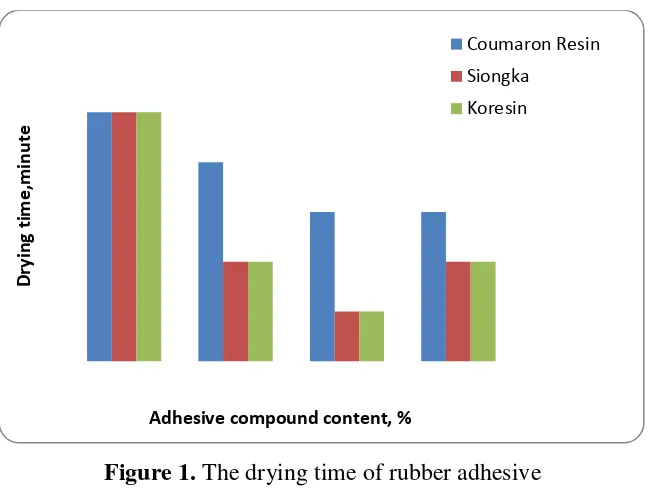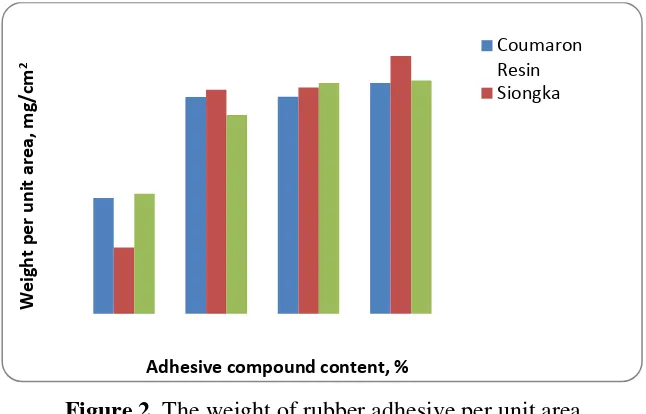Study of Rubber Adhesive Compounds for Tire Retreading: Drying Rate and
Adhesion Strength
Ike Setyorini1,*, Herminiwati1
1
Center for Leather, Rubber and Plastics, Jl. Sokonandi No. 9 Yogyakarta, 55166, Indonesia *Corresponding author. Telp.:+62 274 512929, 563939, Fax.: +62 274 563655
E-mail: [email protected]
ABSTRACT
The scope of this article istostudy the drying rate and the adhesion strength of rubberadhesive compounds that used three different tackifiers i.e. Coumaron Resin, Siongka, and Koresin. The rubber adhesive compounds were diluted in n-Hexane with the content of rubber adhesion compounds was 12 %, 13 %, 14 %, and 15 %. And then it was spread on the surface of 2,5 x 15 cm testpiece of the casing (worn tire)and retreading tire compounds.A time until the adhesive is slightly dry was used to determine the drying rate. The test piece of casing and
retreading tire compounds was taped in one piece and pressed at 170o. The adhesion strength was
tested according to JIS K6301.The results showthat thebestrubber adhesive is an adhesive that uses
Siongka as the tackifier with thesolid content of 14%, adhesion strength
4.15kg/cm,weight13.653mg/cm2and drying time 5 minutes.
INTRODUCTION
The adhesive is a material that is capable to stick fast to surface or object. There is a large
number of adhesive types for various aplication. One of the applications of adhesive is in tire
retreading (Kumar, 2016). Rubber to rubber bonding is common in tire industries. Bonding of
vulcanized elastomers to themselves and to other materials is generally accomplished using an
adhesive derived from an elastomer similar to the one being bonded. Natural rubber is one of the
rubber-based materials that is used as adhesive (Ebnesajjad, 2011; Rippel & Galembeck, 2009).
The adhesive composition that is applied in tire retreading is a thermoset adhesive.
Thermoset adhesive is crosslinked by polymeric resins that are cured using heat and/or heat and
pressure. Rubber based adhesives may contain a wide variety of component materials such as
elastomers, resins, tackifiers, fillers, plasticizers and softeners, antioxidants, curing agents, etc
(Khan & Poh, 2011). The adhesive comprises a rubber composition containing a sulfur curative
together with carbon black, processing oil, and tackifier resin (US Patent, 2000). Tackifiers are
chemical compounds used in formulating adhesives to increase the tack, the stickiness of the
surface of the adhesive. The tackifier acts as a diluent to develop the flowability of the and
improves the peel strength (Sasaki et al., 2008). Tackifiers used are usually resins. Tackifiying resin
that was usually usedcan be divided in three groups: hydrocarbon resins, rosin resins, and phenolic
resins. Coumarone-indene resin is one of hydrocarbon resins. Coumarone-indene resin was used as
the tackifier of a natural rubber–based press- are-sensitive adhesive. The viscosity and tack of the
adhesive is affected by resin content due to the concentration effect of tackifier resin (Poh & Chee,
2007). Hydrocarbon tackifier and rosin tackifier were applied in epoxidize natural rubber
latex-based pressure sensitive adhesive. Hydrocarbon tackifier lower viscosity as a result of increased
repulsion between particles as compared to rosin ester tackifier. The peel adhesion of adhesive
containing hydrocarbon tackifier was greater than adhesive containing rosin ester tackifier (Rohani
et al., 2013). Koresin is aphenolic resin that was applied to provide tack of rubber compounds
during the building process of green tires until they are vulcanized(Durairaj, 2013).
This paper studied the properties of rubber adhesive compounds for tire retreading that used
three different tackifiers i.e. Coumaron Resin, Siongka, and Koresin. Coumaron resin representative
hydrocarbon tackifier resin, Siongka representative rosin tackifier resin from pine trees, and Koresin
representative phenolic tackifier resin. The adhesive compounds were diluted in solvent for several
MATERIALS AND METHODS
Materials
Suitable worn tires were used in this study as the casing that is glued together with tire
retreading compound. The polymer used in this study as an adhesive is Ribbed Smoked Sheet 1
(RSS1). The additives materials used were zinc oxide (ZnO) Indoxide, actiplast 8, stearic acid
Aflux 42M, Carbon Black N660, insoluble sulfur, vulkanox HS, Coumaron Resin (C), Siongka (S),
Koresin (K), Vulkacit DM/C, and n-hexane.
Methods
Compounding
Rubber adhesive compound’s preparation was made with the composition and formulation
that are presented in Table 1.
Table 1. Formulation of rubber adhesive compound
Materials C S K
Table 2. Formulation of rubber adhesive
Rubber Adhesive Compound Content of Compound (%)
12 13 14 15
C C12 C13 C14 C15
S S12 S13 S14 S15
Bonding Process
Rubber adhesive compounds were diluted in n-hexane. Then, the rubber adhesive was
spread on the surface of 2,5 x 15 cm testpiece of casing and tire retreading compound. Allow the
spreading of rubber adhesive a few moment until the rubber adhesive is slightly dry. Record the
drying time and the amount of the rubber adhesive that is spreaded on the surface of the testpiece.
Adhesion Testing
The testpiece of casing and tire retreading compounds which have been spreaded with
rubber adhesive was taped in one piece and pressed in hot vulcanizing press at 170oC. Then, the
testpiece placed in the conditioning room for 24 hours. Adhesion testing of testpiece according to
JIS K6301.
RESULT AND DISCUSSION
Figure 1. shows the drying time of rubber adhesive solution that spread on casing and tire
retreading compound.
Figure 1. The drying time of rubber adhesive
The drying time of rubber adhesive is affected by the amount of rubber adhesive content in
the solvent. Figure 1 shows that the greater adhesive compound content, the faster the drying time.
This is because the greater adhesive compound content has less amount of solvent so that it takes
less time to evaporate. In tire retreading manufacturing, drying time of rubber adhesive is related to
Figure 2. shows the weight of rubber adhesive dilution per unit area of casing and tire
retreading compound.
Figure 2. The weight of rubber adhesive per unit area
Figure 2 shows that each type of tackifier shows tendency that the greater of solids, the
greater the weight of rubber adhesive per unit area. The weight of rubber adhesive per unit area is
related to adhesive viscosity. In tire retreading process, the solvent is use to reduce the viscosity of
rubber adhesive so that they can be applied in the tire smoothly and spreads uniformly (Kumar,
2016). The thick rubber adhesive is difficult to spread on the surface of casing and tire retreading
compound. So, the rubber adhesive does not spread evenly on the surface. Rubber adhesive that is
too thick is easy to peel because rubber adhesive is only bonded to one side (casing or tire
retreading compound). Otherwise, rubber adhesive that is too thin contains a small rubber adhesive
compound, so the adhesion strength is small.
Figure 3. Adhesion strength of rubber adhesive
Figure 3 shows the adhesion strength of rubber adhesive that bond casing and tire retreading
compound. Figure 3 shows that tackifier and adhesive compound content give effect in adhesion
strength. Siongka as tackifier at various adhesive content has a relatively higher in adhesion
strength than Coumarone Resin and Koresin. This is probably because Siongka as a natural tackifier
is more compatible with natural rubber as the raw material of adhesive compound. It is similar to
the natural resins isolated from the coagulated latex of E. caducifolia, that improving tack strength
properties in the filled NR compound comparable to CI resin at equal loading.
CONCLUSION
Coumaron resin, Siongka, and Koresin were used as the tackifier in rubber adhesive
compounds. The drying time of rubber adhesive is affected by the amount of rubber adhesive
content in the solvent. The adhesion strength is affected by adhesive compound content and
tackifier that used in rubber adhesive compounds. Siongka as tackifier has a relatively higher
adhesion strength than Coumarone resin and Koresin. This is probably because Siongka as a natural
tackifier is more compatible with natural rubber adhesive.
ACKNOWLEDGEMENTS Multifunctional Additive in Filled.Rubber Chemistry and Technology. 90(3).429-444. http://doi.org/10.5254/rct.16.83775
Ebnesajjad, S. (2011). Adhesives for special adherends. Handbook of Adhesives and Surface
Preparation. Elsevier Inc. http://doi.org/10.1016/B978-1-4377-4461-3.10011-2
Khan, I., & Poh, B. T. (2011). Natural Rubber-Based Pressure-Sensitive Adhesives: A Review.
Journal of Polymers and the Environment, 19(3), 793–811.
http://doi.org/10.1007/s10924-011-0299-z
Kumar, S. A. (2016). Tyre Retreading by Hot Retreading Process. International Journal of Applied
Science and Engineering, 4(2), 61. http://doi.org/10.5958/2322-0465.2016.00007.1
Poh, B. T., & Chee, C. L. (2007). Effect of coumarone-indene resin on adhesion property of SMR
20-based pressure-sensitive adhesives. International Journal of Polymeric Materials and
Polymeric Biomaterials, 56(3), 247–255. http://doi.org/10.1080/00914030600812483
Majumdar,et al. (2000). United States Patent No. 5951797[19]. Washington, USA: U.S. Patent and
Rippel, M. M., & Galembeck, F. (2009). Nanostructures and adhesion in natural rubber: New era
for a classic. Journal of the Brazilian Chemical Society, 20(6), 1024–1030.
http://doi.org/10.1590/S0103-50532009000600004
Rohani, A. B., Manroshan, S., & Devaraj, V. (2013). Evaluation of Epoxidized Natural Rubber Latex Based Pressure Sensitive Adhesives Containing Hydrocarbon and Rosin Ester Tackifier
Dispersions on Adhesive Properties. Advanced Materials Research, 845, 189–193.
http://doi.org/10.4028/www.scientific.net/AMR.845.189
Sasaki, M., Fujita, K., Adachi, M., Fujii, S., Nakamura, Y., & Urahama, Y. (2008). The effect of tackifier on phase structure and peel adhesion of a triblock copolymer pressure-sensitive
adhesive. International Journal of Adhesion and Adhesives, 28(7), 372–381.
http://doi.org/10.1016/j.ijadhadh.2007.11.002


